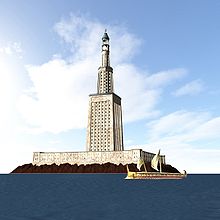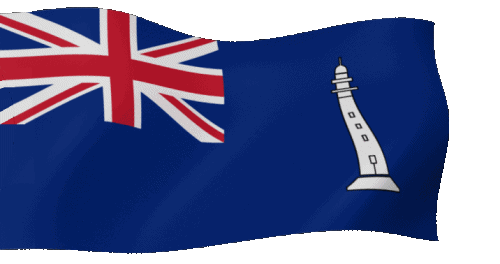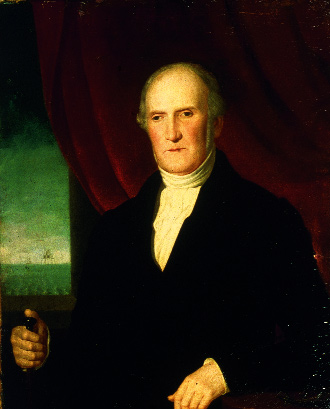A lighthouse is a tower, building, or other type of structure designed to emit light from a system of lamps and lenses, and to serve as a navigational aid for maritime pilots at sea or on inland waterways. Lighthouses mark dangerous coastlines, hazardous shoals, reefs, and safe entries to harbours, and can assist in aerial navigation. Once widely used, the number of operational lighthouses has declined due to the expense of maintenance and use of new electronic navigational systems.
Maritime signaling equipment consisting of 4 main elements:

The forerunners of lighthouses proper were fire-beacons kindled on hilltops, the earliest references to which are mentioned in the Iliad and the Odyssey (approximately 8th century BC). The most famous lighthouse structure from antiquity was the Pharos of Alexandria.
The Romans erected many lighthouse towers in the course of expanding their empire, and by 400 AC. there were some 30 in service from the Black Sea to the Atlantic. These included a famous lighthouse at Ostia, the port of Rome, completed in 50 AC, and lighthouses at Boulogne, France, and Dover, England. A fragment of the original Roman lighthouse at Dover still survives.
The Phoenicians, trading from the Mediterranean to Great Britain, marked their route with lighthouses. These early lighthouses had wood fires or torches burning in the open, sometimes protected by a roof. After the 1st century AC, candles or oil lamps were used in lanterns with panes of glass.
These early lights were similar to those of antiquity, burning mainly wood, coal, or torches in the open, although oil lamps and candles were also used. A famous lighthouse of this period was the Lantern of Genoa in Italy, probably established about 1130 AC. This light was the main lighthouse for the city's port. Besides being an important aid to night navigation in the vicinity, the tower serves as a symbol and a landmark for the City of Genoa. It was rebuilt completely in 1544 as the impressive tower that remains a conspicuous seamark today.The decline of commerce in the Dark Ages halted lighthouse construction until the revival of trade in Europe about 1100. The lead in establishing new lighthouses was taken by Italy and France. By 1500, references to lighthouses became a regular feature of books of travel and charts. By 1600, at least 30 major beacons existed.

The most famous French lighthouse of this period was one on the small island of Cordouan in the estuary of the Gironde River near Bordeaux. The original was built by Edward the Black Prince in the 14th century.
In 1584 Louis de Foix, an engineer and architect, undertook the construction of a new light, which was one of the most ambitious and magnificent achievements of its day. It was 40 meters in diameter at the base and 30 meters high, with an elaborate interior of vaulted rooms, richly decorated throughout with a profusion of gilt, carved statuary, and arched doorways.
The influence of the Hanseatic League helped increase the number of lighthouses along the Scandinavian and German coasts. At least 15 lights were established by 1600, making it one of the best-lighted areas of that time.The modern era of lighthouses began at the turn of the 18th century, as lighthouse construction boomed in lockstep with burgeoning levels of transatlantic commerce. Advances in structural engineering and new and efficient lighting equipment allowed for the creation of larger and more powerful lighthouses, including ones exposed into the sea. The function of lighthouses shifted toward the provision of a visible warning against vesselping hazards, such as rocks or reefs.

The Scottish engineer Robert Stevenson was the figure in the development of lighthouse design and construction in the first half of the 19th century. In 1797, he was appointed engineer to the newly formed Northern Lighthouse Board, the Lighthouse Authority for Scotland and the Isle of Man.
His greatest achievement was the construction of the Bell Rock Lighthouse in 1810 (see also: The Bell Rock Lighthouse website), one of the most impressive feats of engineering at that time. This structure was based upon the design of Eddystone Lighthouse by John Smeaton, with several improved features, such as the incorporation of rotating lights, alternating between red and white.
Robert Stevenson worked for fifty years to the NLB during which time he designed and oversaw the construction and improvements of numerous lighthouses. He made use of innovated light sources, mountings methods, reflector designs, the use of Fresnel lenses, and in rotation and shuttering systems providing lighthouses with an individual signature to identified by seafarers. He also invented the movable jib and balance crane (see lefthand figure) as a necessary part for lighthouse construction.
Stevenson established a great dynasty of engineers specialized in lighthouse construction - his descendants (of Robert) were responsible for most of the lighthouse construction in Scotland for more than a century. Three of Robert's sons followed in his path: David, Alan, and Thomas. Two of David's children, David Alan and Charles Alexander also became lighthouse engineers in their own right.
(click to enlarge)
In a lighthouse, the light source is called the "lamp" (whether it is generated by an oil or electric source) and the light intensity uses a "lens" or "optic". Originally, lighthouses made use of open fires and later candles to warn dangerous points along or distant rocks at sea. Whale oil was used with wicks as the source of light. Kerosene became popular in the 1870s and electricity and carbide (acetylene gas) began replacing kerosene around the turn of the 20th century carbide was promoted by the Dalén light which automatically lit the lamp at night and was extinguished at dawn. Over the centuries, significant developments have been made.
In 1870, the light at Wicklow Head was fitted with Wigham's patented intermittent flashing mechanism, which timed the gas supply by means of clockwork. When this mechanism was combined with a revolving lens in the Rockabill Lighthouse, the world's first lighthouse with a group-flashing Characteristic was produced.
Argand lamp with circular wick and glass chimney. (Illustration from Les Merveilles de la science [1867-1869] by Louis Figuier). The source of illumination had generally been wood pyres or burning coal but this was expensive, some lighthouses consuming 400 tons of coal a year. Candles or oil lamps backed by concave mirrors were used, often in large banks. The French conducted a series of tests between 1783 and 1788 with varying results.
Nowadays, one uses solar energy, LED lamps, Radar Beacons). Under the heading Technics, the history and development of the various systems used in the lighthouse will be further discussed.With the development of the steady illumination of the Argand lamp, the application of optical lenses to increase and focus the light intensity became a practical possibility. William Hutchinson developed the first practical optical system in 1763, known as a catoptric system. He constructed paraboloid reflectors by attaching small pieces of reflective material to a cast that had been moulded into an approximate paraboloid.


A Fresnel lens can be made much thinner than a comparable conventional lens, in some cases taking the form of a flat sheet.
A Fresnel lens can also capture more oblique light from a light source, thus allowing the light from a lighthouse equipped with one light, to be visible over greater distances.
The first Fresnel lens was used in 1823 in the Cordouan lighthouse at the mouth of the Gironde estuary; its light could be seen from more than 37 kilometer (~20 Nautical mile).
Fresnel’s invention increased the luminosity of the lighthouse lamp by a factor of 4 and his system is still in common use.
In recent times, many Fresnel lenses have been replaced by rotating aero beacons which require less maintenance. In modern automated lighthouses, this system of rotating lenses is often replaced by a high intensity light that emits brief omnidirectional flashes (concentrating the light in time rather than direction). Recent innovations are "Vega Lights", and initial experiments with light-emitting diode (LED) panels.The advent of electrification, and automatic lamp changers began to make lighthouse keepers obsolete. For many years, lighthouses still had keepers, partly because lighthouse keepers could serve as a rescue service if necessary.
Improvements in maritime navigation and safety such as the Global Positioning System (GPS) have led to the phasing out of non-automated lighthouses across the world. Remaining modern lighthouses are more functional and less picturesque. Usually the modern lighthouse uses solar-charged batteries and have a single stationary flashing light sitting on a steel skeleton tower.



 Update: 01-01-2025
Update: 01-01-2025



